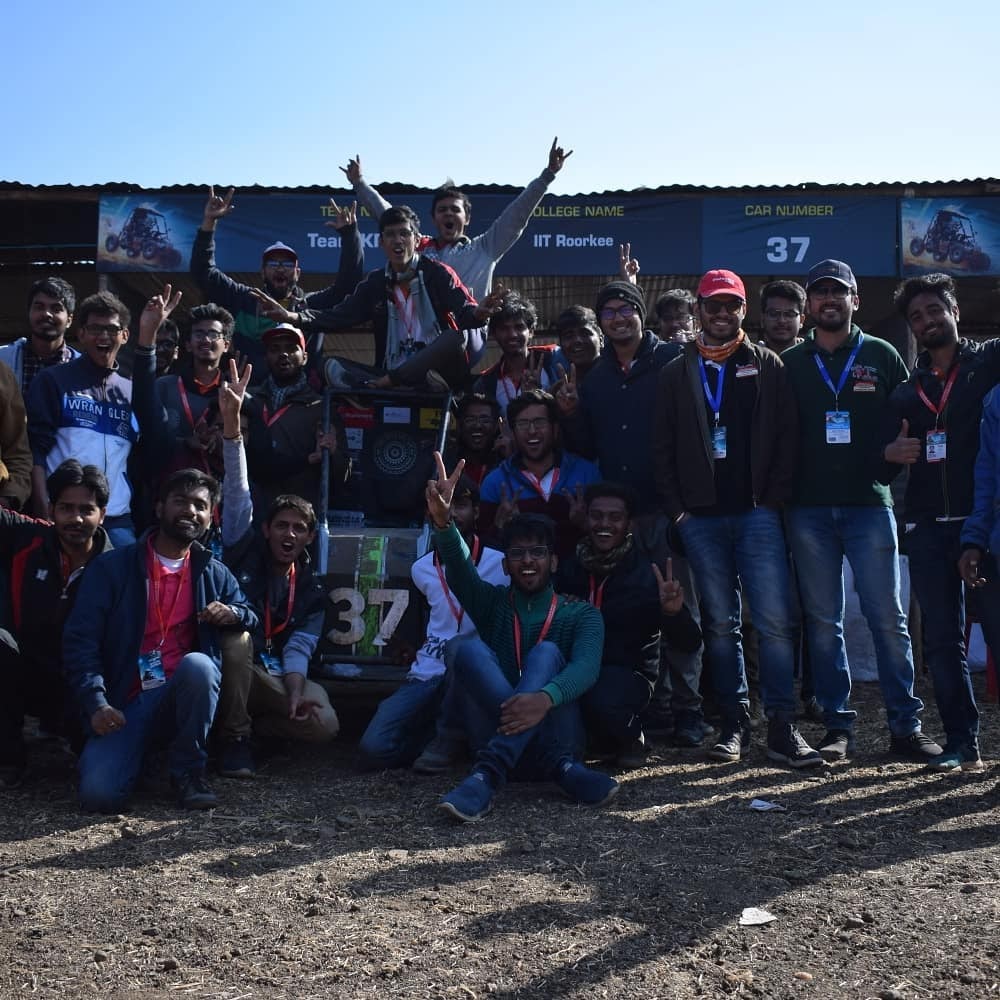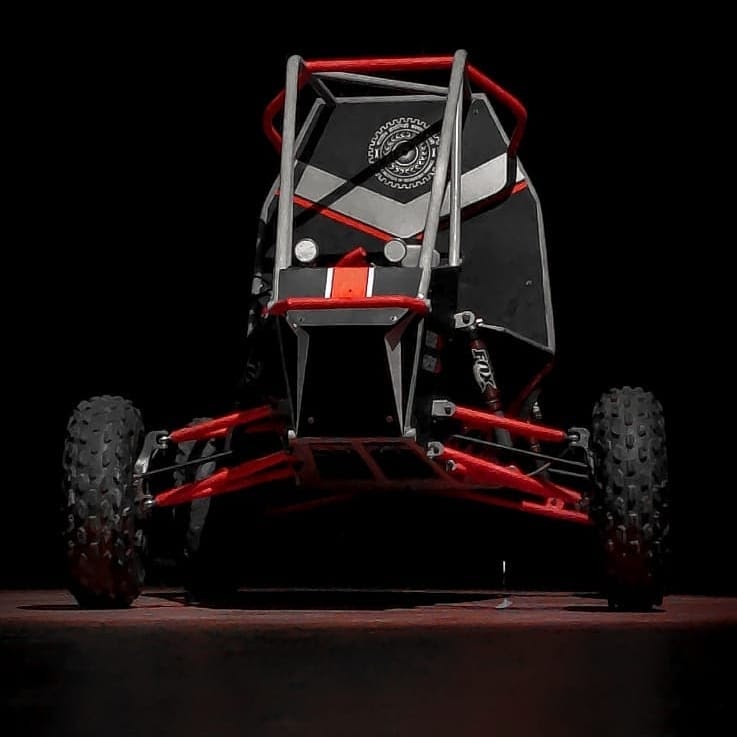

Body of IITR

On the 10th of January, Team KNOx unveiled its latest automotive vehicle N-IITR-O to the campus junta. The team is all set to participate in the upcoming BAJA SAE competition.
WatchOut! decided to interview them to know more about their preparations and their journey so far.
WO: What exactly is the BAJA SAE competition, and what is the history of your team in this competition?
Team KNOx: BAJA SAE is an intercollegiate design competition. It started in America. They particularly started by building trucks that could run on any terrain. What we build is a mini BAJA, the small vehicle, weighing around 200 kgs. Teams from various colleges in India, as well as the world, participate in this competition. In India, the event is held at two sites, at Indore around the Republic day and at Ropar in March. This year the competition is from the 23rd to the 26th of January.
Our team participated in this event for the first time in 2010. We ranked among the top ten teams consecutively in 2010,2011 and 2012. Somehow we could not participate after that and could only send the vehicle again in 2016, which failed the endurance test. A similar thing happened in 2018 as well. In 2019, we ran through the endurance for about 2 hours, but again had a breakdown and couldn’t finish the race. We are hoping that we don’t experience a similar kind of failure this year and finish well in the race.
WO: Can you give us a few more details about the event?
Team KNOx: On day one at the event, a technical inspection is done. A check is conducted to see if the vehicle complies with the rulebook. After our vehicle passes this phase, another test is done for safety purposes - a brake test. We are given an (approximately) hundred feet trek. We are expected to run the vehicle at a speed of forty kilometres per hour. Then brakes are applied. We have to stop at a distance within ten feet, and all the four tyres should lock. Else, the vehicle will not pass, and we will not be allowed to attend any upcoming events. After that, the acceleration of the vehicle is tested. These are the first three events. Coming to the dynamic events, we are expected to drive our vehicle from one end to the other of a road littered with boulders. There are events for maneuverability, traction (of the tires), steering ability, and the driving skills of the driver.
Then there is an event where our vehicle has to face challenges. . Then there is a sales presentation, where we are asked about how we will sell the ATV, and how we will attract investors. Additionally, there is a design presentation, where we are judged based on our design, and the changes that have been made in its implementation. The final event is endurance. It comprises of four hundred marks (out of a thousand). It is the main focus of the competition and lasts for four hours.
WO: What exactly is the endurance round which you are talking about?
Team KNOx: Endurance round comprises of four hours of rigorous testing of the vehicle. The lap consists of different types of rough terrains like rock crawl and mud bog. There are approximately 150 teams who participate in the endurance test, but after around 2 hours, only 10-15 remain. This is to tell you how brutal the track is.
WO: Participating in a competition of such stature must have required a lot of dedication, hard work and planning. What has been your preparation process for the event?
Team KNOx: After coming back from the competition last year in January, all the sub-departments of our team sat together to look upon the mistakes we had made and to think about the changes that had to be done. After deciding the changes, we made a budget for every sub-department under the supervision of our team captain, and then by the end of February, we started working on the design. We were done by the end of March. We have the first round, the Virtuals, for the competition in June. In this round, we are judged on the basis of the presentation of the design of the ATV and also the full vehicle assembly. The judges decide whether the model we submit is feasible or not. We cleared the virtuals and were given the opportunity to represent ourselves in the main event, which is going to happen now.
After getting selected, we began with the manufacturing phase. First of all, we made a timeline for every sub-department. We had a plan to finish the manufacturing by November, and after that, we were ready for testing our ATV. We tried to make similar tracks as we are going to face in the competition. After testing, we went for the documentation of the vehicle, and now we are all set for the event.
WO: How supportive is the administration, with regards to financial and infrastructural assistance?
Team KNOx: Our workshops are comfortable. However, if anything needs to be repaired, a long procedure is required. If the process (for funds) was online, it would be better. Right now, we have to fill out a form in advance, then submit it. It involves a lot of paperwork and is bureaucratic. If it was online, it would be beneficial. Our workshops and departments are pretty old, and sometimes the machinery gets filled with water. If we want them cleaned or removed, we have to wait for a month and a half. Manufacturing starts in August and ends in January. We can design in our rooms, but manufacturing has to be done in our labs, and the monsoon comes in the middle.
WO: What are the significant changes in the vehicle and your strategy this year?
Team KNOx: In 2017, we could not participate in the event because we could not clear the virtuals. Then in 2018, we faced issues related to the budget, and also the senior members of the team didn’t have the requisite experience with manufacturing. Yet,, we made it to the competition in 2018, after a gap of a year but could not perform that well. We improved a lot in 2019, and our vehicle could finish 16-17 laps in 2 hours in the endurance round. But we had a breakdown after that. This time, we have worked a lot on the wheel assembly, which had caused the failure last year

WO: What are the difficulties that you faced as a team?
Team KNOx: The first difficulty that one faces is the kind of output the seniors give or how they pass on the knowledge and information to the juniors. That was the problem we met in 2017 when we could not enter the event, after which we had only one senior left in our team because of whom we could make it to the competition in 2018. This hasn’t been the problem after that. The difficulty we face now is related to the manufacturing process. Though we have a vast amount of information and we can design everything correctly, there are only a few parts which we can actually manufacture ourselves, the rest of them have to be procured from Delhi, Pune or Chennai. This year we had to go to a vendor in Pune for CNC machining of specific components. He had promised to deliver the assemblies by the end of October but the delivery as made by the end of November. The whole manufacturing process, thus, got delayed by around a month, because of which we could not test the vehicle for the duration we had planned for. This is the biggest hurdle that we’ve faced. There are also certain issues like the tiresome process of documentation and running for funds here and there. Sometimes the team has to contribute funds to get things done. These are the two main problems that we face.
WO: What kind of competition do you anticipate this year? Which institutions are expected to give your team stiff competition?
Team KNOx: The competition is very tough. Before 2019, 120 teams qualified for the main event; the count has now increased to 150, making the competition tougher. Institutions like College of Engineering, Pune, MIT Pune, and NIT Kurukshetra have an o utstanding track record, and we are aiming to beat them this year.
WO: What kind of training do you give to the driver of the ATV and how do you decide who should be the one to drive the ATV?
Team KNOx: We have a team of about thirty people, and we choose the driver from these thirty people itself. First of all, the driver should have a driving license, that is compulsory. Along with this, the person needs to be fit; all the physical criteria for the same must be satisfied. The car is designed according to the 95th percentile rule which states that 95 per cent of the population should be able to sit in the car properly so it’s evident that we cannot make a very tall or a hefty guy the driver. The driver should be as light as possible because that will improve the performance of the vehicle by enhancing fuel efficiency. 5-6 people qualify these parameters. Then we check how the driver handles the car on the track. For this, we give them the vehicle for testing, and then 2 or 3 of them are finally selected out of whom the fittest is chosen as the driver and the rest as co-drivers. This year Piyush is the driver.
WO: Do accidents occur on the day of the competition? How do you ensure the safety of the driver in such a case?
Team KNOx: The rulebook which is allotted to us for the manufacturing process is concerned with the safety of the drivers. From the manufacturing phase itself, safety is a consideration. On the day of the event, we have a five-point harness, fireproof suit, and a helmet set that is sfi rated, for the driver. To deal with instances of a fire breaking out, the front cockpit and the rear cockpit are completely separated by an aluminium sheet. The rear cockpit has the engine and the fuel tank. The fuel tank is checked at the event site for any fuel leakage. In case of any emergency, there is a fire extinguisher attached to the vehicle. For further safety of the driver, there is a kill switch on the steering, and another at the back of the vehicle. A volunteer can then stop the engine immediately.
WO: In a race like this, how important is the pit crew? What skillset are they expected to have?
Team KNOx: The pit crew is the most crucial part of the team. If any failure occurs, or the car suffers a breakdown in the endurance test (or any event), the car is rushed to the pit. The job of the pit crew is to quickly identify the problem - which parts are broken or require servicing and promptly change it. If spares are unavailable, they should be able to work out how to make do without that particular part. This requires problem-solving abilities and quick thinking. They need to be level headed because time is of the essence (the race lasts for only four hours). If they panic, they will be unable to solve the problem and may even worsen the situation. Throughout the year, while the vehicle is still in the manufacturing and testing phases, we identify people for this task. We select twenty-five members who come through in all the situations and take them for the competition.
WO: What additional supplies and resources do you carry, and how likely are they to impact your chance of winning the competition?
Team KNOx: We carry spares of every critical component and components which have a low factor of safety. We keep the factor of safety low for some components to reduce weight. If we increase the factor of safety, then the weight will be significantly increased. This can make the difference between losing and winning because if a component fails and there are no spares available, and the part is such that without it the car cannot run, we will be out of the race. This year, we have worked a lot on the design and have made most of the parts failure-proof. If the worst happens, we have spares of these parts.
WO: Was there any exciting incident that occurred while you were preparing for this competition?
Team KNOx: A funny incident occurred when we had our first run. Our team captain was driving, and his leg got stuck on the accelerator pedal. He accidentally hit the car on a pipe that was on our set, and it got a dent on it. Many such incidents occur during the testing phase too. Once, we were testing the drop of our vehicle from a five feet high cliff. Our driver kept the vehicle too slow. The moment the car left the cliff, a rollover occurred. Our driver was upside down and lying by the car. Another comic incident that happened was that our machine has a part made up of tubes. When we start the car, there is something known as idling, which means that when the vehicle is started, it shouldn’t run immediately, or begin to accelerate on its own. Our car is checked for idling. Two years ago, a component wasn’t welded properly, and our captain was holding it and standing (to make sure the car didn’t run). The engine was started, and behold! The tube remains in hand, while the car has run away.